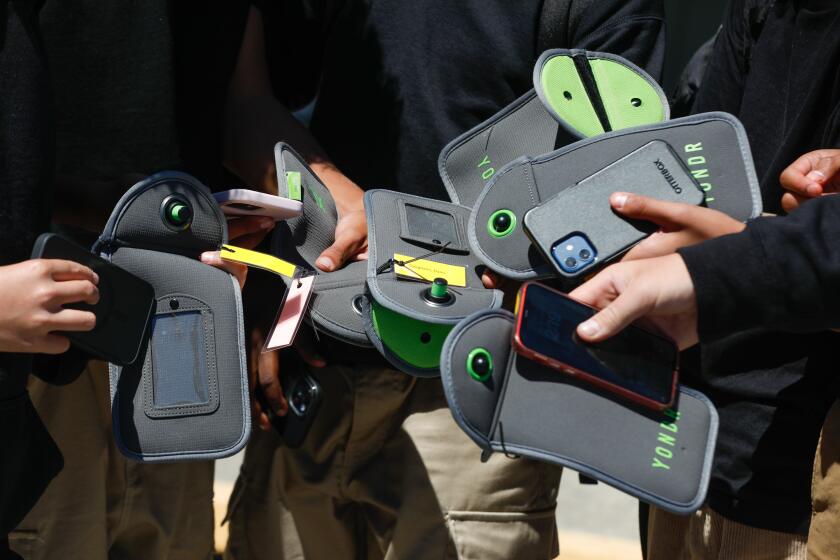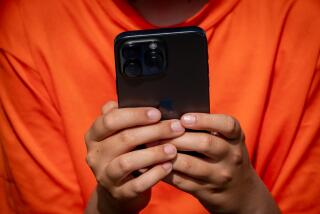New law in Brazil is making students put away their cellphones at school

- Share via
SÃO PAULO — Brazilian students returned to class this week with a new task: staying away from their smartphones as a new law restricting their use in schools took effect.
President Luiz Inácio Lula da Silva signed a bill in January limiting smartphone access at schools, in line with a trend seen in the U.S. and Europe. It applies to public and private schools, and applies to classrooms and the halls.
Phones are still allowed for educational purposes, with the teacher’s permission, and when needed for the student’s accessibility and health. Schools can set their own guidelines, such as whether students can keep phones in backpacks or store them in lockers or other designated receptacles.
LAUSD says its student cellphone ban will start Feb. 18. Schools will decide how to restrict phones, from telling students to put them in backpacks to using magnetically sealed pouches.
Before the federal law, most of Brazil’s 26 states had already applied some restrictions to phone use in schools. As of 2023, nearly two-thirds of Brazilian schools had some limitations, with 28% banning them entirely, according to a survey last year by the Brazilian Internet Steering Committee.
But rules varied between states and between schools, and authorities and administrators struggled with enforcement.
That may have contributed to support for federal legislation from across the political spectrum — including allies of both the leftist Lula and the far-right former President Jair Bolsonaro. A survey released in October by Brazilian pollster Datafolha said that almost two-thirds of respondents wanted to ban smartphone use by children and teenagers at schools. More than three-quarters said the devices do more harm than good to their children.
Porto Seguro, a nearly 150-year-old private school in Sao Paulo, prohibited smartphones in classrooms last year and encouraged students to disconnect completely once a week. This year, it expanded its ban to include hallways.
“Banning cellphone use has helped create a space for social interaction, fostering relationships and teaching students to navigate conflicts, which are a natural part of human interactions,” school principal Meire Nocito said. “It has been very positive.”
One of the highest rates of phone use
In May, Fundacao Getulio Vargas, a leading think-tank and university, said Brazil had more smartphones than people, with 258 million devices for a population of 203 million.
Local market researchers said last year that Brazilians spend an average of 9 hours and 13 minutes per day on screens, which is among one of the world’s highest rates of use.
Institutions, governments, parents and others have for years associated smartphone use by children with bullying, suicidal ideation, anxiety and loss of concentration necessary for learning. China moved last year to limit children’s use of smartphones, while France has in place a ban on smartphones in schools for kids ages 6 to 15.
Cellphone bans have gained traction across the United States, where eight states have passed laws or policies that ban or restrict cellphone use to try to minimize distractions in classrooms.
A report published in September by the U.N.’s Educational, Scientific and Cultural Organization, or UNESCO, said 1 in 4 countries have already restricted the use of such devices at schools.
New ways to interact with friends
Meta Chief Executive Mark Zuckerberg used a U.S. Senate hearing last year to apologize to parents of children exploited, bullied or driven to self-harm via social media. He also noted Meta’s continued investments in “industrywide” efforts to protect children.
Students, whose cellphones are an extension of their very being, mull pending L.A. school ban of the devices with praise and frustration.
Mariana Waetge, a 13-year-old student at Porto Seguro, has owned a smartphone for five years. She uses it to communicate with friends and family and to find entertainment on social media, especially Instagram. Being forced to stay away from her phone made her find new ways to interact with friends, improved her focus and even strengthened her relationship with her family, she said.
The restriction also helped “include people who didn’t have many friends and would use their phones to hide from making new friends or to avoid being out there,” she said. “Now they don’t have that option anymore. These people end up playing board games or reading books.”
Pessoa writes for the Associated Press. AP videojournalist Thiago Mostazo contributed to this report.
More to Read
Sign up for Essential California
The most important California stories and recommendations in your inbox every morning.
You may occasionally receive promotional content from the Los Angeles Times.













